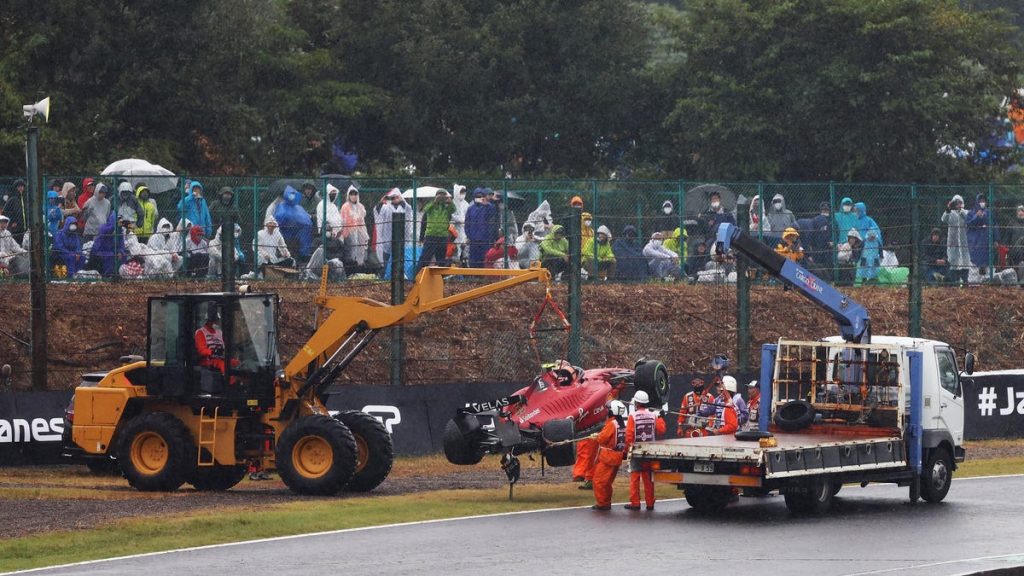FIA Announces Changes Following F1's Tractor Incident in Japan

Photo: Bryn Lennon – Formula 1 (Getty Images)
Ignoring the confusion over whether on not Max Verstappen won the 2022 F1 World Drivers’ Championship, Formula 1’s drivers left Japan seriously concerned over the handling of an incident early in the rain-affected race. On the second lap, Carlos Sainz lost control of his Ferrari at the exit of Suzuka’s hairpin and aquaplaned into the barriers. The safety car was deployed, then marshals and a recovery vehicle were sent to the severely damaged Ferrari at the track’s edge.
This created a situation where the field past next to the crash site in conditions where the visibility was so low that the tractor was almost invisible at distance. This wasn’t much of an issue for the drivers paced around the circuit by the safety car. However, AlphaTauri’s Pierre Gasly had recently left the pit lane and was trying to catch the safety car queue alone. Gasly blew past the tractor in wet conditions, immediately conjuring memories of Jules Bianchi’s crash in 2014. He furiously exclaimed on the radio, “I could have killed myself.”
After the race, the Fédération Internationale de l’Automobile stated that it would investigate the incident, release its findings and make appropriate changes. The report was released today with a full timeline of events from race control’s perspective. The FIA determined that all of the organization’s procedures were followed. However, it also noted that Pierre Gasly was not detected entering the pit lane and that a recovery vehicle should not have been deployed until all the cars were behind the Safety Car.
Pierre Gasly circling Suzuka CircuitPhoto: Philip Fong/AFP (Getty Images)
The FIA stated:
The review noted that in such conditions, a recovery vehicle should not be deployed unless all cars are aligned behind the Safety Car. Furthermore, marshals and recovery equipment would only be deployed whilst cars are on track (Safety Car periods) when the weather conditions and location of the cars to be recovered allow for a quick and safe intervention.
Given the track conditions and the overall visibility for drivers, marshals and recovery staff at the time, initially under a Safety Car followed by a Red Flag, and as efforts were focused on safe recovery, the AlphaTauri of Pierre Gasly in the Pit Lane was not immediately detected.
Race Control do not necessarily monitor all cars that may pit during Safety Car periods as they are more concerned about any area containing an incident and neutralising the field behind the Safety Car.
G/O Media may get a commission
49% off
Cordless Leaf Blower
Leaves … leave now.
his lightweight but powerful motor runs on a rechargeable battery, and includes two tubes for maximum reach.
The FIA will implement a raft of measures to prevent this incident from happening again. The official messaging and intercom systems will be used to inform the teams where a recovery vehicle has been deployed. Software will be developed for Race Control and the Remote Operations Center (ROC) in Geneva to keep track of the cars during Safety Car and Virtual Safety Car periods. Procedures will also be update to better allocate tasks across the Race Control staff and delegate tasks to the ROC.
Motorsport’s governing body also feels it is necessary to make changes to help protect the drivers from themselves. Pierre Gasly had been driving over 120 miles per hour in wet conditions to close the gap to the Safety Car, which he admitted was a mistake. The FIA notes that the drivers are obligated to limit their speed when the race is under yellow and red flags and “apply common sense at all times.” The Virtual Safety Car rules are also going to allow the mandated speed delta to be changed dynamically in portions of the track where an incident has taken place. This will make the drivers more aware of where the dangers are and also force them to slow down.
Eduardo Freitas (left) now has a bit more free timePhoto: Drew Gibson (Getty Images)
The FIA has relieved Eduardo Freitas of his duties as one of two Formula 1 Race Directors. Niels Wittich will be the sole chief official for the season’s remainder. Freitas will remain the Race Director of the FIA World Endurance Championship, a position he has held since the sports car series’ inaugural season in 2012. The governing body also mentioned that further discussion and assessment of track drainage at Suzuka and the current use of advertising boards are necessary. It is clear that the FIA is taking this incident seriously and making significant changes to ensure that it doesn’t happen again.



